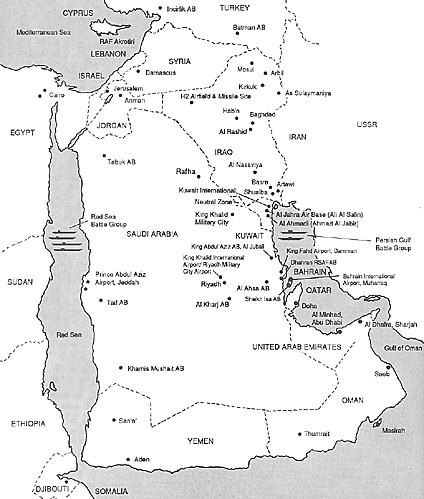Note: Due to the Length of this supplement, we could not fit it all into this issue of Command Post Quarterly. This installment includes the order of battle and table of organization for all of the Coalition forces. The next installment, in CPQ #5, will contain the Iraqi order of battle and TO&Es plus all vehicles and weapons ratings and a bibliography.
The Persian Gulf War (a.k.a. the 100-Hour War, ak.a. the War to Liberate Kuwait, a.k.a. the Mother of All "Mother of All" jokes) was foughtjust three years ago in a world that is increasingly alien to us inhabitants of the mid-1990s. In Command Post #4 (as opposed to Command Post Quarterly #4, which you are reading now), a rough Gulf War Guide for Command Decision/Combined Arms was presented, based on information available at the time. In the months since the dramatic conclusion to the war, it is not surprising that more information has become available. What is surprising to me is the tremendous post-war indifference to an event that is now "remembered" as a dull, foregone conclusion, never mind that it was anticipated with six months of fear, loathing, and cable television.
This supplement is more than a painstakingly researched update on a "heat of the moment" order of battle, it is an opportunity to remember how it really was. Remember back to the fall of 1990 when George Bush was the only person on this Earth who believed he could assemble a miraculous Arab-Western coalition, and get the United Nations to do anything but posture and deadlock. Remember what is was like to wince every time you heard that another Scud had smacked into Israel, the sound of reporters talking through gas masks, and the BANG of Patriot missiles coming through your tiny television speaker. Put yourself in the position of US officers in February of 1991, who fully expected to see their soldiers die in the border barriers under Iraqi chemical barrages, or in the position of a soldier in a 1st Infantry Division breaching unit which was expected to take 60% casualties. And finally, try to imagine, when it was all over, what it would be like to realize, in the words of one American officer, "that I was no longer expecting to die."
We may respond to history in many ways, but we have no right to ever imagine that we find it dull, even if in retrospect we believe it to be anticlimactic. Three years later, this new world order may not be what we expected, but history always presents lessons that must be learned. Perhaps it is that people can change the world with vision, will, and courage. Perhaps it is that if vision and will are not maintained, those changes can soon be overtaken by other less desirable ones. Or perhaps the lesson is as simple as the fact that history is made by people "most remarkable like you."
History is luminous because it is full of people.
Invasion
The Iraqi Invasion of Kuwait on August 2, 1990 brought the fourth largest army in the world (owned by a country with more tanks per capita than any other in the world) into a small desert state that had historically relied on alliances and agreements as a means of defense. With Kuwait overrun, the next possible target for Saddam Hussein appeared to be Saudi Arabia, and so President Bush arranged a US military build-up in a Moslem nation which had never allowed a foreign military presence. The UN condemned the Iraqi invasion not once but several increasingly passionate times, and the United States called upon other countries to become involved. The stage was set for Desert Shield, the Coalition build-up in the Gulf.
As the orders of battle and units present varied over the next six months, the following Order of Battles are for the start of the ground war on February 24, 1991. Prior to this date, many of the units listed below were attached to other commands.
Only major ground formations are listed immediately below, and not even all of these are relevant to Command Decision/Combined Arms games. Organizational breakdowns of combat formations used in CD/CA are in the TO&E section starting on page 18. Numerous supporting units are also listed, but do not have organizational breakdowns as they are included only for historical interest and completeness. Conspicuous by their absence are the numerous supply, service suppom and transportation units. This is not to slight their accomplishment, certainly the great victory would not have taken place without them. However, I plead simply they are far too numerous to list here, information on them is hard to come by, and they are not used in CD/CA games.
Aviation units are accompanied by their aircraft complements (in CD/CA terms, not real world numbers), and do not reappear in the TO&E section. In the listings below, when the name Command Decision (CD) is used, it also refers to the Combined Arms version of those rules.
See future issues of CPQ for scenarios in the "Operation Desert Storm Studies" series.

More Gulf War
-
Introduction
Coalition Forces: Joint Forces Command
Coalition Forces: CENTCOM US Central Command
Coalition Forces: SOCCENT Special Operations Command
Coalition Forces: JSOTF Joint Special Operations Task Force
Coalition Forces: MARCENT Marine Corps Component
Coalition Forces: NAVCENT Naval Component
Coalition Forces: CENTAF/9th Air Force: Air Force Component
Coalition Forces: EUCOM US European Command
Coalition Forces: NATOACE North Atlantic Treaty Org. Allied Command Europe, Mobile Force
Back to Table of Contents -- Command Post Quarterly #4
To Command Post Quarterly List of Issues
To MagWeb Master Magazine List
© Copyright 1994 by Greg Novak.
This article appears in MagWeb (Magazine Web) on the Internet World Wide Web.
Other military history articles and gaming articles are available at http://www.magweb.com
